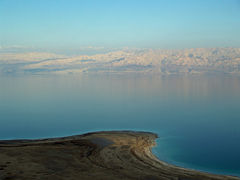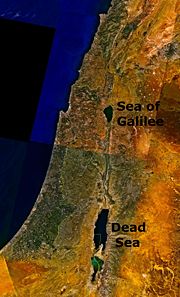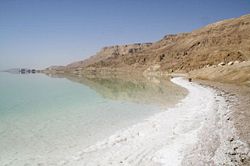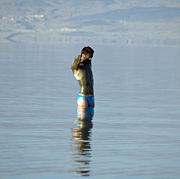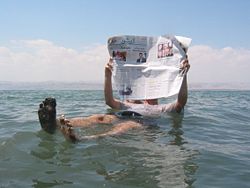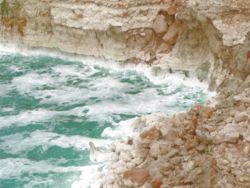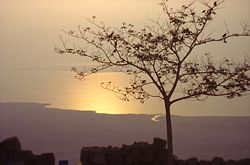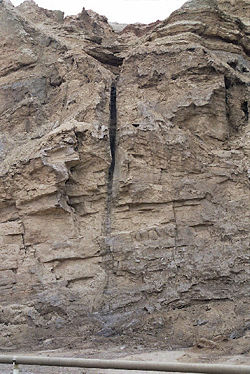Dead Sea
2008/9 Schools Wikipedia Selection. Related subjects: Geography
| Dead Sea | |
|---|---|
|
|
|
| Coordinates | |
| Lake type | endorheic hypersaline |
| Primary inflows | Jordan River |
| Primary outflows | evaporation |
| Catchment area | 40,650 km² (15,700 sq mi) |
| Basin countries | Jordan Israel West Bank |
| Max. length | 67 km (42 mi) |
| Max. width | 18 km (11 mi) |
| Surface area | 810 km² (310 sq mi) North Basin |
| Average depth | 120 m (394 ft) |
| Max. depth | 330 m (1,083 ft) |
| Water volume | 147 km³ (35 cu mi) |
| Shore length1 | 135 km (84 mi) |
| Surface elevation | -420 m (-1,378 ft) |
| References | |
| 1 Shore length is not a well-defined measure. | |
The Dead Sea (Arabic: البَحْر المَيّت, al-Baḥrᵘ l-Mayyitᵘ, "Dead Sea";Hebrew: יָם הַמֶּלַח, Yām Ha-Melaḥ, "Sea of Salt") is a salt lake between Israel and the West Bank to the west, and Jordan to the east. It is 420 metres (1,378 ft) below sea level, and its shores are the lowest point on the surface of the Earth on dry land. The Dead Sea is 330 m (1,083 ft) deep, the deepest hypersaline lake in the world. It is also the world's second saltiest body of water, after Lake Asal in Djibouti, with 30 percent salinity. It is 8.6 times saltier than the ocean. Experts say that it is nine times saltier than the Mediterranean Sea (31.5% salt versus 3.5% for the Mediterranean). The Dead Sea is 67 kilometres (42 mi) long and 18 kilometres (11 mi) wide at its widest point. It lies in the Jordan Rift Valley, and its main tributary is the Jordan River.
The Dead Sea has attracted visitors from around the Mediterranean basin for thousands of years. Biblically, it was a place of refuge for King David. It was one of the world's first health resorts (for Herod the Great), and it has been the supplier of a wide variety of products, from balms for Egyptian mummification to potash for fertilizers.
In Arabic the Dead Sea is called al-Bahr al-Mayyit ("the Dead Sea"), or less commonly baḥrᵘ lūṭᵃ (بحر لوط, "the Sea of Lot"). Another historic name in Arabic was the "Sea of Zoʼar", after a nearby town. In Hebrew, the Dead Sea is Yām ha-Melaḥ , meaning "sea of salt," or Yām ha-Māvet (ים המות, "sea of death"). In antiquity it was sometimes referred to as Yām ha-Mizraḥî (ים המזרחי, "the Eastern sea") or Yām ha-‘Ărāvâ (ים הערבה, "Sea of the Arabah"). The Greeks called it Lake Asphaltites ( Attic Greek ἡ Θάλαττα ἀσφαλτῖτης, hē Thálatta asphaltĩtēs, "the Asphaltite sea.
Natural history
The Dead Sea is an endorheic lake located in the Jordan Rift Valley, a geographic feature formed by the Dead Sea Transform (DST). This left lateral-moving transform fault lies along the tectonic plate boundary between the African Plate and the Arabian Plate. It runs between the East Anatolian Fault zone in Turkey and the northern end of the Red Sea Rift offshore of the southern tip of Sinai. There are two contending theories about the origin of the low elevation of the Dead Sea. The older theory is that it lies in a true rift zone, an extension of the Red Sea Rift, or even of the Great Rift Valley of eastern Africa. A more recent theory is that the Dead Sea basin is a consequence of a "step-over" discontinuity along the Dead Sea Transform, creating extension of the crust with consequent subsidence.
Around three million years ago what is now the valley of the Jordan River, Dead Sea, and Wadi Arabah was repeatedly inundated by waters from the Mediterranean Sea. The waters formed in a narrow, crooked bay which was connected to the sea through what is now the Jezreel Valley. The floods of the valley came and went depending on long scale climatic change. The lake that occupied the Dead Sea Rift, named " Lake Sodom", deposited beds of salt, eventually coming to be 3 km (2 miles) thick.
According to geological theory, approximately two million years ago the land between the Rift Valley and the Mediterranean Sea rose to such an extent that the ocean could no longer flood the area. Thus, the long bay became a lake.
The first such prehistoric lake is named "Lake Gomorrah." Lake Gomorrah was a freshwater or brackish lake that extended at least 80 km (50 miles) south of the current southern end of the Dead Sea and 100 km (60 mi) north, well above the present Hula Depression. As the climate turned more arid, Lake Gomorrah shrank and became saltier. The large, saltwater predecessor of the Dead Sea is called "Lake Lisan."
In prehistoric times great amounts of sediment collected on the floor of Lake Gomorrah. The sediment was heavier than the salt deposits and squeezed the salt deposits upwards into what are now the Lisan Peninsula and Mount Sodom (on the southwest side of the lake). Geologists explain the effect in terms of a bucket of mud into which a large flat stone is placed, forcing the mud to creep up the sides of the pail. When the floor of the Dead Sea dropped further due to tectonic forces the salt mounts of Lisan and Mount Sodom stayed in place as high cliffs. (see salt domes)
From 70,000 to 12,000 years ago the lake level was 100 m (328 ft) to 250 m (820 ft) higher than its current level. This lake, called "Lake Lisan", fluctuated dramatically, rising to its highest level around 26,000 years ago, indicating very wet climate in the Near East. Sometime around 10,000 years ago the lake level dropped dramatically, probably to levels even lower than today. During the last several thousand years the lake has fluctuated approximately 400 m (1,310 ft) with some significant drops and rises. Current theories as to the cause of this dramatic drop in levels rule out volcanic activity, therefore it may have been a seismic event.
The Jordan River is the only major water source flowing into the Dead Sea. There are no outlet streams.
The northern part of the Dead Sea receives scarcely 100 mm (4 in) of rain a year. The southern section barely 50 mm (2 in). The Dead Sea zone's aridity is due to the rainshadow effect of the Judean Hills. The highlands east of the Dead Sea receive more rainfall than the Dead Sea itself.
The mountains of the western side, the Judean Hills, rise less steeply from the Dead Sea than do the mountains of the eastern side. The mountains of the eastern side are also much higher. Along the southwestern side of the lake is a 210 m (700 ft) tall halite formation called " Mount Sodom".
Climatic features and therapies
The Dead Sea's climate offers year-round sunny skies and dry air with low pollution. It has less than 100 millimetres (3.94 in) mean annual rainfall and a summer average temperature between 32 and 39 °C (90-102°F). Winter average temperatures range between 20 and 23 °C (68-74°F). The region has weakened ultraviolet radiation, particularly the UVB (erythrogenic rays), and an atmosphere characterized by a high oxygen content due to the high barometric pressure. The shore is the lowest dry place in the world. Proximity to the sea affects temperatures nearby because of the moderating effect a large body of water has on climate. During the winter months, sea temperatures tend to be higher than land temperatures, and vice versa during the summer months. This is the outcome of slow penetration of the sun's rays into the sea, which is a huge mass that takes a long time to warm up.
The region's climate and the unique conditions created by its low elevation have made it a popular centre for several types of therapies:
- Climatotherapy: Treatment which exploits local climatic features such as temperature, humidity, sunshine, barometric pressure and special atmospheric constituents.
- Heliotherapy: Treatment that exploits the biological effects of the sun's radiation.
- Thalassotherapy: Treatment that exploits bathing in Dead Sea water.
Chemistry and health effects
Until the winter of 1978-1979, the Dead Sea was composed of two stratified layers of water that differed in temperature, density, age, and salinity. The topmost 35 metres (115 ft) or so of the Dead Sea had a salinity that ranged between 300 and 400 parts per thousand and a temperature that swung between 19 °C (66 °F) and 37 °C (98 °F). Underneath a zone of transition, the lowest level of the Dead Sea had waters of a consistent 22 °C (72 °F) temperature and complete saturation of sodium chloride (NaCl). Since the water near the bottom is saturated, the salt precipitates out of solution onto the sea floor.
Beginning in the 1960s water inflow to the Dead Sea from the Jordan River was reduced as a result of large-scale irrigation and generally low rainfall. By 1975 the upper water layer of the Dead Sea was actually saltier than the lower layer. The upper layer nevertheless remained suspended above the lower layer because its waters were warmer and thus less dense. When the upper layer finally cooled down so that its density was greater than the lower layer the waters of the Dead Sea mixed. For the first time in centuries the lake was a homogeneous body of water. Since then stratification has begun to redevelop.
The mineral content of the Dead Sea is significantly different from that of ocean water. The exact composition of the Dead Sea water varies with season, depth, temperature and so on. The concentration of ionic species (in g/kg) of Dead Sea surface water in the early 1980s was found to be: Cl− (181.4), Br− (4.2), SO42− (0.4), HCO3− (0.2), Ca2+ (14.1), Na+ (32.5), K+ (6.2) and Mg2+ (35.2). The total salinity was 276 g/kg. These results show that w/w% composition of the salt, as anhydrous chlorides, was calcium chloride (CaCl2) 14.4%, potassium chloride (KCl) 4.4%, magnesium chloride (MgCl2) 50.8% and sodium chloride (common salt, NaCl) 30.4%. In comparison, the salt in the water of most oceans and seas is approximately 97% sodium chloride. The concentration of sulfate, SO42−, ions is very low, and the bromide ion, Br− concentration is the highest of all waters on Earth.
Comparison between the chemical composition of the Dead Sea to other lakes and oceans show that the salt concentration in the Dead Sea is 31.5% (the salinity fluctuates somewhat). The unusually high concentration of salt results in a similarly high density of up to 1.24 kg/L, depending on temperature and salinity. Anyone can easily float in the Dead Sea because of natural buoyancy. In this aspect, the Dead Sea is similar to the Great Salt Lake in Utah, in the United States.
One of the most unusual properties of the Dead Sea is its discharge of asphalt. From deep seeps, the Dead Sea constantly spits up small pebbles of the black substance. After earthquakes, chunks as large as houses have been found.
The Dead Sea area has become a major centre for health research and treatment for several reasons. The mineral content of the waters, the very low content of pollens and other allergens in the atmosphere, the reduced ultraviolet component of solar radiation, and the higher atmospheric pressure at this great depth each have specific health effects. For example, persons suffering reduced respiratory function from diseases such as cystic fibrosis seem to benefit from the increased atmospheric pressure.
Sufferers of the skin disorder psoriasis also benefit from the ability to sunbathe for long periods in the area due to its position below sea level and subsequent result that many of the sun's harmful UV rays are reduced. Furthermore, Dead Sea salt has been found to be beneficial to psoriasis patients.
Flora and fauna
The sea is called "dead" because its high salinity prevents macroscopic aquatic organisms, such as fishes and aquatic plants, from living in it, though minuscule quantities of bacteria and microbial fungi are present.
In times of flood, the salt content of the Dead Sea can drop from its usual 35% salinity to 30% or lower. The Dead Sea temporarily comes to life in the wake of rainy winters. In 1980, after one such rainy winter, the normally dark blue Dead Sea turned red. Researchers from Hebrew University found the Dead Sea to be teeming with a type of algae called Dunaliella. The Dunaliella in turn nourished carotenoid-containing (red-pigmented) halobacteria whose presence is responsible for the colour change. Since 1980, the Dead Sea basin has been dry and the algae and the bacteria have not returned in measurable numbers.
Many animal species make their homes in the mountains surrounding the Dead Sea. A hiker can see camels, ibex, hares, hyraxes, jackals, foxes, and even leopards. Hundreds of bird species inhabit the zone as well. Both Jordan and Israel have established nature reserves around the Dead Sea.
The delta of the Jordan river was formerly a veritable jungle of papyrus and palm trees. Flavius Josephus described Jericho as "the most fertile spot in Judea". In Roman and Byzantine times sugarcane, henna, and sycamore all made the lower Jordan valley quite wealthy. One of the most valuable products produced by Jericho was the sap of the balsam tree, which could be made into perfume.
By the nineteenth century Jericho's fertility was a thing of the past.
Human history
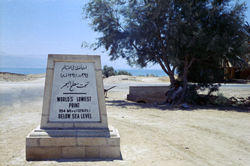
In Judaism
The human history of the Dead Sea goes all the way back to remote antiquity. Just north of the Dead Sea is Jericho. Somewhere, perhaps on the Dead Sea's southeast shore, would be the cities mentioned in the Book of Genesis which were said to have been destroyed in the time of Abraham: Sodom and Gomorra (Genesis 18) and the three other "Cities of the Plain" - Admah, Zeboim and Zoar (Deuteronomy 29:23). Zoar, however, escaped destruction when Abraham's nephew Lot escaped there from Sodom (Genesis 19:21-22). King David was said to have hidden from Saul at Ein Gedi nearby.
Prophecies
In Ezekiel 47:8-9 there is a specific prophecy over the dead sea that the water will ".. be healed and made fresh". The dead sea will become a normal sea and even fish will live in the sea. A similar prophecy is stated in Zechariah 14:8, which says that "Living waters will go out from Jerusalem, half of them to the eastern sea (likely the Dead Sea) and half to the western sea (the Mediterranean)..."
Ancient Greek period
The Greeks knew the Dead Sea as "Lake Asphaltites", due to the naturally surfacing asphalt. Aristotle wrote about the remarkable waters. Later, the Nabateans discovered the value of bitumen extracted from the Dead Sea needed by the Egyptians for embalming their mummies.
Herodian period
King Herod the Great built/rebuilt several fortresses and palaces on the Western Bank of the Dead Sea. The most famous was Masada, where, in 70-73 AD, a small group of rebellious Jewish zealots held out against the might of the Roman Legion, and Machaerus where, according to Josephus, John the Baptist was imprisoned by Herod Antipas and met his death.
Also in Roman times some Essenes had settled on the Dead Sea's western shore; Pliny the Elder identifies their location with the words, "on the west side of the Dead Sea, away from the coast ... [above] the town of Engeda" (Natural History, Bk 5.73); and it is therefore a hugely popular though not uncontested hypothesis today, that same Essenes are identical with the settlers at Qumran and that "the Dead Sea Scrolls" discovered during the 20th century in the nearby caves had been their own library.
In Christianity
The remoteness of the region attracted Greek Orthodox monks since the Byzantine era. Their monasteries such as Saint George in Wadi Kelt and Mar Saba in the Judean Desert are places of pilgrimage.
In Islam
In Islamic tradition, the Dead Sea was about the land in which the Prophet Lut ( Lot in the Hebrew scriptures) lived. The people of the towns and cities were wicked for their acts of homosexuality, raping men, robbery and murder and had therefore been given a punishment for such deeds. The punishment arrived when angels in the form of beautiful men were sent down by God as guests for Lut to host. When Lut's people heard of the men, they rushed to Lut's house to misbehave and rape the men. This was their final test which they failed so the angels raised the land where the prophet's people lived, tipped it upside down and threw it back on earth, causing the ground near the impact to cave in. Thus, the lowest land on Earth was formed because of this punishment. The non-believers (in the monotheism doctrine) were destroyed and the followers were saved. According to some interpretation, the sura of ar-Rum of the Quran refers to the Dead Sea as the lowest place on Earth.
Bedouin tribes have continuously lived in this area, and more recently explorers and scientists arrived to analyze the minerals and conduct research into the unique climate. Tourism in the region has been developed since the 1960s.
Recent History
The Dead Sea Scrolls were found in caves at Qumran at the Dead Sea. The world's lowest road, Highway 90, runs along the Israeli and West Bank shores of the Dead Sea at 393 m (1,289 ft) below sea level.
There are also health spas and hot springs along the shore, besides the unique water of the Dead Sea itself. A golf course named for Sodom and Gomorrah was built by the British at Kalia on the northern shore. The first major hotels were built in Israel, first at nearby Arad, and since the 1960s at the Neve Zohar resort complex. The Jordanian side has seen increasing development in recent years, and includes international franchises.
Industry
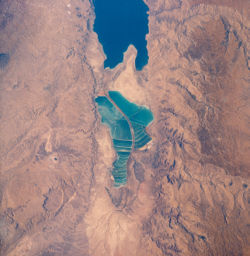
In the early part of the 20th century, the Dead Sea began to attract interest from chemists who deduced that the Sea was a natural deposit of potash and bromine. The Palestine Potash Company was chartered in 1929 after its founder, Siberian Jewish engineer and pioneer of Lake Baikal exploitation Moses Novomeysky, worked for the charter ex for over ten years. The first plant was on the north shore of the Dead Sea at Kalia and produced potash, or potassium chloride, by solar evaporation of the brine. Employing Arabs and Jews, it was an island of peace in turbulent times. The company quickly grew into the largest industrial site in the Middle East and in 1934 built a second plant on the southwest shore, in the Mount Sodom area, south of the 'Lashon' region of the Dead Sea. Palestine Potash Company supplied half of Britain's potash during World War II, but ultimately became a casualty of the 1948 Arab-Israeli War. Its remnants were nationalised and Dead Sea Works Ltd. was established in 1952 in its stead as a state-owned company to extract potash and other minerals from the Dead Sea.
From the Dead Sea brine, Israel produces (2001) 1.77 million tons potash, 206,000 tons elemental bromine, 44,900 tons caustic soda, 25,000 tons magnesium metal, and sodium chloride. On the Jordanian side of the Dead Sea, Arab Potash (APC), formed in 1956, produces 2.0 million tons of potash annually, as well as sodium chloride and bromine. Both companies use extensive salt evaporation pans that have essentially diked the entire southern end of the Dead Sea for the purpose of producing carnallite, potassium magnesium chloride, which is then processed further to produce potassium chloride. The power plant on the Israeli side allows production of magnesium metal (by a subsidiary, Dead Sea Magnesium Ltd.). The salt evaporation pans are visible from space.
Due to the popularity of the sea's therapeutic and healing properties, several companies have also shown interest in the manufacturing and supplying of Dead Sea salts as raw materials for body and skin care products. Companies, like the San Francisco Bath Salt Company and Cleopatra's Choice, for example, are based in the United States but import their supply of Dead Sea salts directly from Israel.
Recession
In recent decades, the Dead Sea has been rapidly shrinking because of diversion of incoming water. From an elevation of 395 m (1,296 ft) below sea level in 1970 it fell 22 m (72 ft) to 418 m (1,371 ft) below sea level in 2006, reaching a drop rate of 1 m (3 ft) per year. Although the Dead Sea may never entirely disappear, because evaporation slows down as surface area decreases and salinity increases, it is feared that the Dead Sea may substantially change its characteristics.
The Dead Sea level drop has been followed by a groundwater level drop, causing brines that used to occupy underground layers near the shoreline to be flushed out by freshwater. This is believed to be the cause of the recent appearance of large sinkholes along the western shore – incoming freshwater dissolves salt layers, rapidly creating subsurface cavities that subsequently collapse to form these sinkholes.
One of the plans which were suggested as a means to stop the recession of the Dead Sea is to channel water from the Mediterranean or the Red Sea, either through tunnels or canals (the Dead Sea Canal). Although a Mediterranean structure would be shorter, Israel is now committed to building a Red Sea canal in deference to Jordan's needs. The plan is to pump water 120 m (394 ft) up the Arava/Arabah from Aqaba or Eilat, tunnel under the highest point of the Arava/Arabah valley, and then canalize the river of seawater as it falls 520 m (1,706 ft) to the Dead Sea. The downhill flow would be harnessed hydroelectrically, and the arriving seawater would run into a desalination plant to be constructed in Jordan. The salt water remaining after desalination would be deposited into the Dead Sea.
On May 9, 2005, Jordan, Israel, and the Palestinian Authority signed an agreement to begin feasibility studies on the project, to be officially known as the " Two Seas Canal". The scheme calls for the pumping of 870 million cubic metres of sea water from the Red Sea per year and generation of 550 Mega watts of electricity. The World Bank is supportive of the project. However, several environmental groups have raised concerns about possible negative impacts of the project on the natural environment of the Dead Sea and Arava.
In 2007, the level of the Dead Sea fell by 1 metre.
